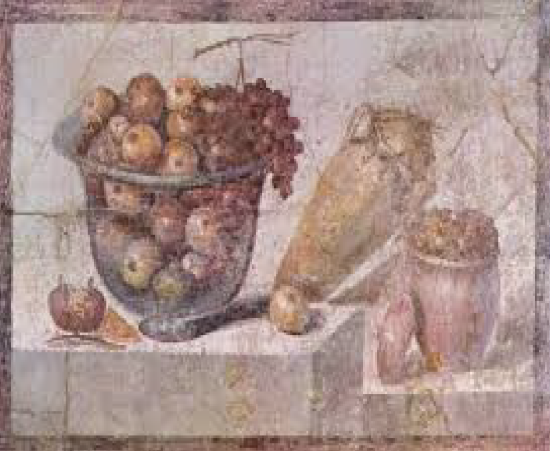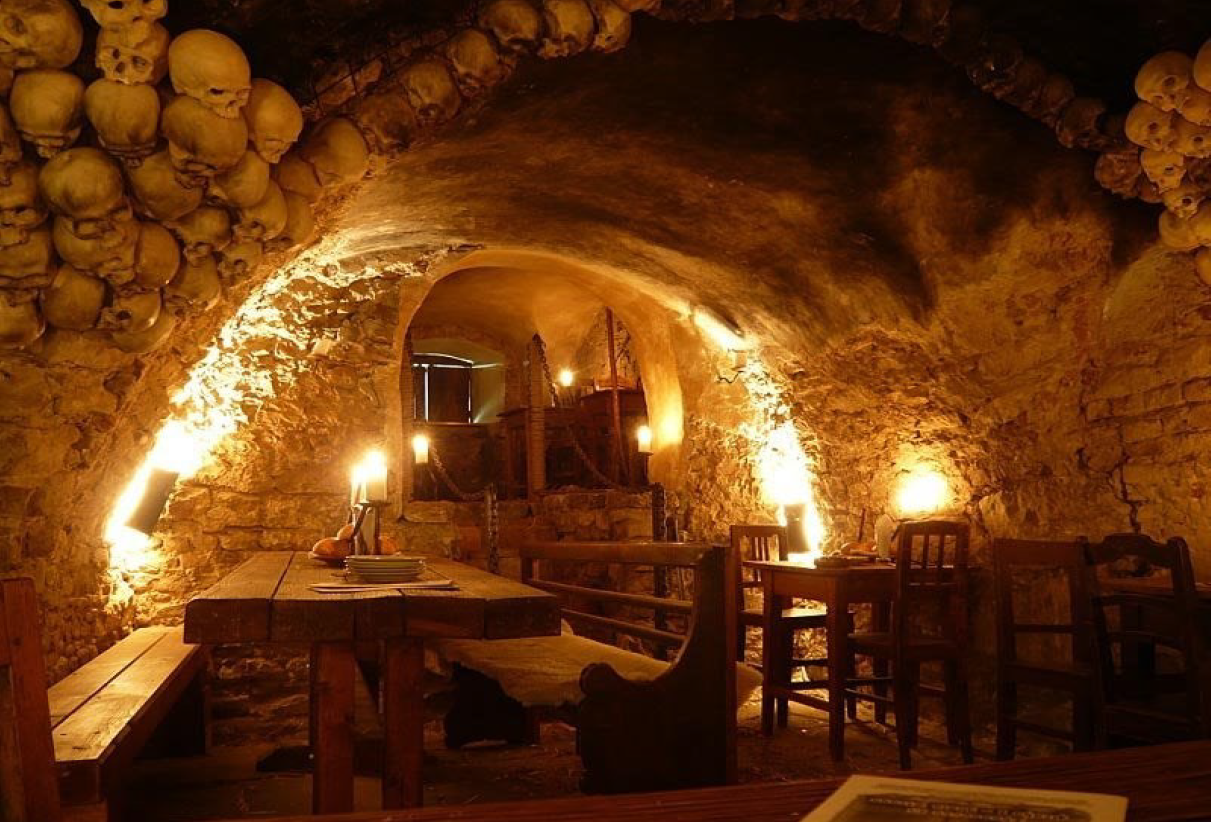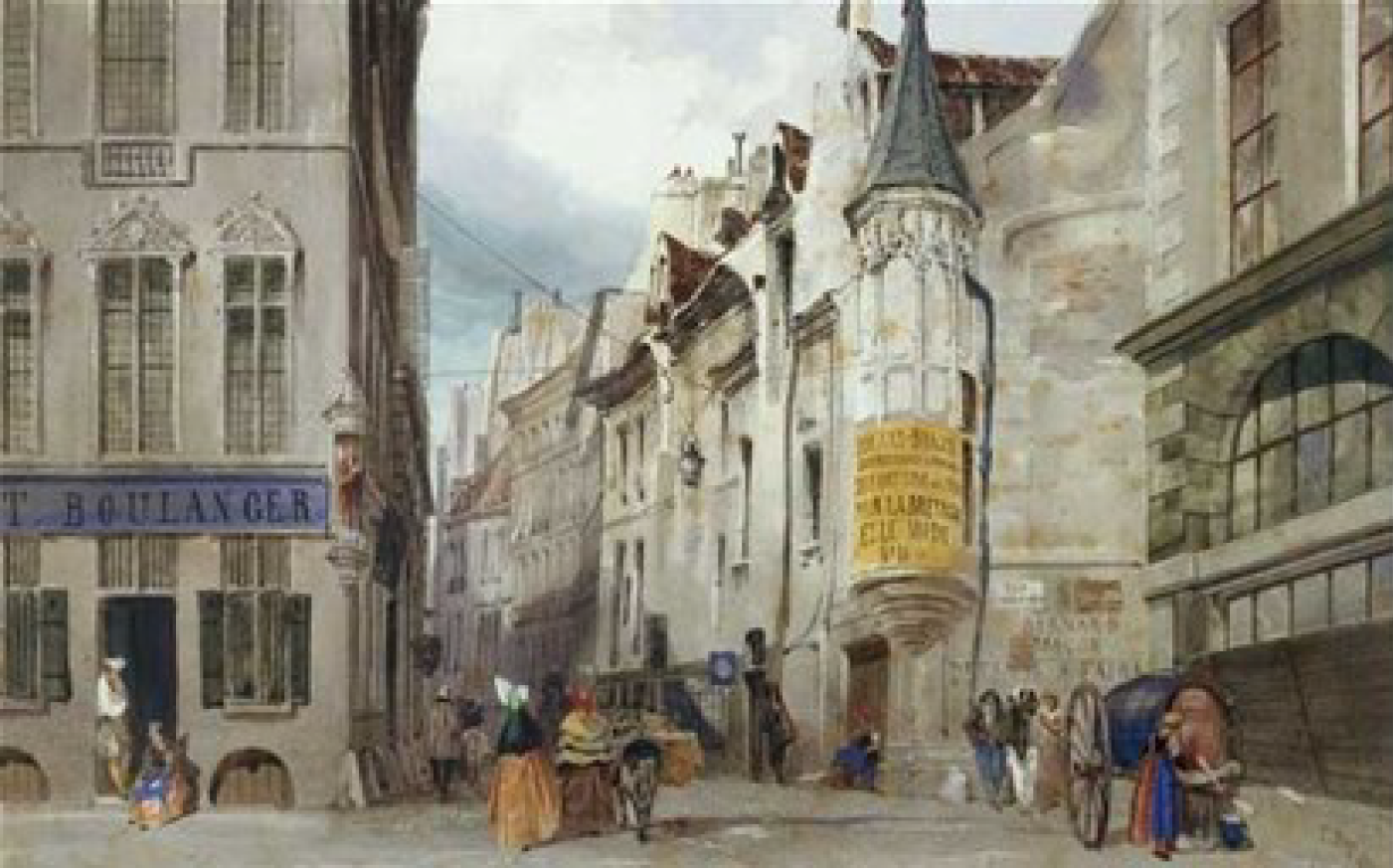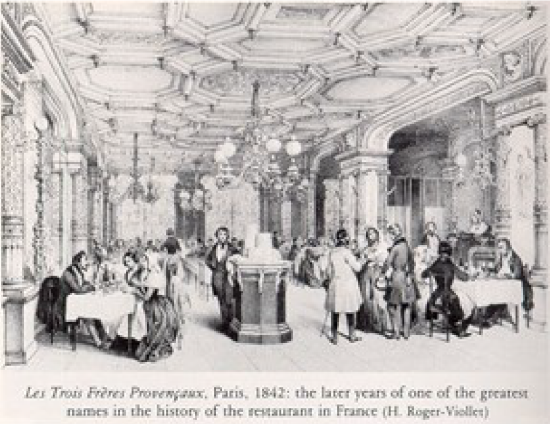1.1: History of Restaurants
- Page ID
- 21827
\( \newcommand{\vecs}[1]{\overset { \scriptstyle \rightharpoonup} {\mathbf{#1}} } \)
\( \newcommand{\vecd}[1]{\overset{-\!-\!\rightharpoonup}{\vphantom{a}\smash {#1}}} \)
\( \newcommand{\id}{\mathrm{id}}\) \( \newcommand{\Span}{\mathrm{span}}\)
( \newcommand{\kernel}{\mathrm{null}\,}\) \( \newcommand{\range}{\mathrm{range}\,}\)
\( \newcommand{\RealPart}{\mathrm{Re}}\) \( \newcommand{\ImaginaryPart}{\mathrm{Im}}\)
\( \newcommand{\Argument}{\mathrm{Arg}}\) \( \newcommand{\norm}[1]{\| #1 \|}\)
\( \newcommand{\inner}[2]{\langle #1, #2 \rangle}\)
\( \newcommand{\Span}{\mathrm{span}}\)
\( \newcommand{\id}{\mathrm{id}}\)
\( \newcommand{\Span}{\mathrm{span}}\)
\( \newcommand{\kernel}{\mathrm{null}\,}\)
\( \newcommand{\range}{\mathrm{range}\,}\)
\( \newcommand{\RealPart}{\mathrm{Re}}\)
\( \newcommand{\ImaginaryPart}{\mathrm{Im}}\)
\( \newcommand{\Argument}{\mathrm{Arg}}\)
\( \newcommand{\norm}[1]{\| #1 \|}\)
\( \newcommand{\inner}[2]{\langle #1, #2 \rangle}\)
\( \newcommand{\Span}{\mathrm{span}}\) \( \newcommand{\AA}{\unicode[.8,0]{x212B}}\)
\( \newcommand{\vectorA}[1]{\vec{#1}} % arrow\)
\( \newcommand{\vectorAt}[1]{\vec{\text{#1}}} % arrow\)
\( \newcommand{\vectorB}[1]{\overset { \scriptstyle \rightharpoonup} {\mathbf{#1}} } \)
\( \newcommand{\vectorC}[1]{\textbf{#1}} \)
\( \newcommand{\vectorD}[1]{\overrightarrow{#1}} \)
\( \newcommand{\vectorDt}[1]{\overrightarrow{\text{#1}}} \)
\( \newcommand{\vectE}[1]{\overset{-\!-\!\rightharpoonup}{\vphantom{a}\smash{\mathbf {#1}}}} \)
\( \newcommand{\vecs}[1]{\overset { \scriptstyle \rightharpoonup} {\mathbf{#1}} } \)
\( \newcommand{\vecd}[1]{\overset{-\!-\!\rightharpoonup}{\vphantom{a}\smash {#1}}} \)
\(\newcommand{\avec}{\mathbf a}\) \(\newcommand{\bvec}{\mathbf b}\) \(\newcommand{\cvec}{\mathbf c}\) \(\newcommand{\dvec}{\mathbf d}\) \(\newcommand{\dtil}{\widetilde{\mathbf d}}\) \(\newcommand{\evec}{\mathbf e}\) \(\newcommand{\fvec}{\mathbf f}\) \(\newcommand{\nvec}{\mathbf n}\) \(\newcommand{\pvec}{\mathbf p}\) \(\newcommand{\qvec}{\mathbf q}\) \(\newcommand{\svec}{\mathbf s}\) \(\newcommand{\tvec}{\mathbf t}\) \(\newcommand{\uvec}{\mathbf u}\) \(\newcommand{\vvec}{\mathbf v}\) \(\newcommand{\wvec}{\mathbf w}\) \(\newcommand{\xvec}{\mathbf x}\) \(\newcommand{\yvec}{\mathbf y}\) \(\newcommand{\zvec}{\mathbf z}\) \(\newcommand{\rvec}{\mathbf r}\) \(\newcommand{\mvec}{\mathbf m}\) \(\newcommand{\zerovec}{\mathbf 0}\) \(\newcommand{\onevec}{\mathbf 1}\) \(\newcommand{\real}{\mathbb R}\) \(\newcommand{\twovec}[2]{\left[\begin{array}{r}#1 \\ #2 \end{array}\right]}\) \(\newcommand{\ctwovec}[2]{\left[\begin{array}{c}#1 \\ #2 \end{array}\right]}\) \(\newcommand{\threevec}[3]{\left[\begin{array}{r}#1 \\ #2 \\ #3 \end{array}\right]}\) \(\newcommand{\cthreevec}[3]{\left[\begin{array}{c}#1 \\ #2 \\ #3 \end{array}\right]}\) \(\newcommand{\fourvec}[4]{\left[\begin{array}{r}#1 \\ #2 \\ #3 \\ #4 \end{array}\right]}\) \(\newcommand{\cfourvec}[4]{\left[\begin{array}{c}#1 \\ #2 \\ #3 \\ #4 \end{array}\right]}\) \(\newcommand{\fivevec}[5]{\left[\begin{array}{r}#1 \\ #2 \\ #3 \\ #4 \\ #5 \\ \end{array}\right]}\) \(\newcommand{\cfivevec}[5]{\left[\begin{array}{c}#1 \\ #2 \\ #3 \\ #4 \\ #5 \\ \end{array}\right]}\) \(\newcommand{\mattwo}[4]{\left[\begin{array}{rr}#1 \amp #2 \\ #3 \amp #4 \\ \end{array}\right]}\) \(\newcommand{\laspan}[1]{\text{Span}\{#1\}}\) \(\newcommand{\bcal}{\cal B}\) \(\newcommand{\ccal}{\cal C}\) \(\newcommand{\scal}{\cal S}\) \(\newcommand{\wcal}{\cal W}\) \(\newcommand{\ecal}{\cal E}\) \(\newcommand{\coords}[2]{\left\{#1\right\}_{#2}}\) \(\newcommand{\gray}[1]{\color{gray}{#1}}\) \(\newcommand{\lgray}[1]{\color{lightgray}{#1}}\) \(\newcommand{\rank}{\operatorname{rank}}\) \(\newcommand{\row}{\text{Row}}\) \(\newcommand{\col}{\text{Col}}\) \(\renewcommand{\row}{\text{Row}}\) \(\newcommand{\nul}{\text{Nul}}\) \(\newcommand{\var}{\text{Var}}\) \(\newcommand{\corr}{\text{corr}}\) \(\newcommand{\len}[1]{\left|#1\right|}\) \(\newcommand{\bbar}{\overline{\bvec}}\) \(\newcommand{\bhat}{\widehat{\bvec}}\) \(\newcommand{\bperp}{\bvec^\perp}\) \(\newcommand{\xhat}{\widehat{\xvec}}\) \(\newcommand{\vhat}{\widehat{\vvec}}\) \(\newcommand{\uhat}{\widehat{\uvec}}\) \(\newcommand{\what}{\widehat{\wvec}}\) \(\newcommand{\Sighat}{\widehat{\Sigma}}\) \(\newcommand{\lt}{<}\) \(\newcommand{\gt}{>}\) \(\newcommand{\amp}{&}\) \(\definecolor{fillinmathshade}{gray}{0.9}\)Restaurants are an institution in nearly every country and culture in the world. The restaurant, which emerged during the French Revolution, continues to serve as a place where people come together to eat, drink, and socialize. However, even before Marie Antoinette and Louis XVI were sent to the guillotine, restaurants have been around in one form or another for thousands of years.
Ancient Restaurant, Wikipedia

Fruit Basket, Pompeii, C. AD 70, Wikipedia
The idea of selling food for profit existed during the earliest civilizations. It’s no coincide the growth of restaurants through history correlates with the growth of cities. The need for public eateries was firmly established as far back as the Roman Empire and Ancient China. When peasants and farmers brought their livestock and other goods to urban markets, often they traveled for several days at a time and needed a place to eat and rest. This brought about the earliest form of restaurants, the roadside inn.
Usually located in the middle of the countryside, inns served meals at a common table to travelers. There were no menus or even options from which to choose. Every night was chef’s choice.

Restaurants in the Middle Ages, Wikipedia
In Europe through the Middle Ages and into the Renaissance, taverns and inns continued to be the main place to buy a prepared meal. In Spain, these establishments were called bodegas, which served small savory Spanish dishes called "tapas." In England, food such as sausage and shepherd’s pie were popular; while, in France, stews and soups were offered. All of these early restaurants served simple fare commonly found in peasant or merchant homes.
Following Columbus’s voyage to the Americas in 1492, global trade increased, introducing new foods to Europe. Coffee, tea, and chocolate were soon being served in public houses alongside beer, ale, and wine. By the 17th century, while full meals were still typically eaten at home, moderately well-to-do people would hire a caterer or take their meals in a private salon, rather than in the main dining room of a public house.

France, Wikipedia Commons
In France throughout the Middle Ages, guilds had monopolies on many aspects of prepared food. For example, Charcutiers were the guild who prepared cooked meats for sale. If you did not belong to that particular guild, it was illegal to sell cooked meat in any form. In 1765, a man named Boulanger added cooked lamb to a stew he sold in his shop near the Louvre. The caterer’s guild sued him, but Boulanger won the case. Over the next 20 years leading up to the French Revolution, more shops like Boulanger’s began opening in Paris. Before Mr. Boulanger, guilds brought foods to the inns whose primary functions was to provide beds and drink.
Guilds of the Middle Ages
- Rotisseurs…………….roast spits
- Patissiers……………..poultry, pies, tarts
- Tamisiers……………..bread bakers
- Vinaigriers…………….soups & stews
- Traiteurs………………ragouts
- Porte-chapes…………feasts & celebrations
When Marie Antoinette and Louis XVI went to the guillotine, the old ways of French society went with them. The guilds were swept away and many chefs employed in aristocratic, even royal, households found themselves unemployed. Many of these displaced workers opened their own restaurants in Paris, bringing with them a new way of dining. Delicate china, cutlery, and linen tablecloths, all trappings of aristocracy, were now available to a completely new echelon of French citizens. Menus became more diverse, offering both prix fixe and a la carte options.
Though public houses continued to exist, the rise of fine dining in France would soon spread throughout Europe and into the New World.
Public gatherings over food and drink have long been a part of human society, as they offer a place for people to come together for a meal and to socialize with others. Following the French Revolution, fine dining restaurants expanded across Europe and to other parts of the world.
The Birth of Fine Dining

The term restaurant itself is French, once used to describe the rich bouillons served at taverns and public houses to restore the spirits and relieve ailments (restoratives). Following the French Revolution at the end of the 18th Century, unemployed chefs from aristocratic households began opening their own RESTAURANTS. They added touches of the upper class to their establishments. Guests did not have to take their meals at a common table, as was typical of taverns and roadside inns. Instead, they had private tables, held by reservations- a new concept. Antoine Beauvilliers of the Grande Taverne de Londre was the first to offer a menu, listing dishes during fixed hours served at individual tables.
They dined with fine china and cutlery, and tablecloths- all trademarks of modern day fine dining. Menus, either prix fixe or a la carte were framed and at the end of the meal, guests were presented with a check, tallying the amount of their bill.
Many fortunes were made by these professional chefs-turned-restaurateurs. They catered to a new class of provincial DEPUTES that came to Paris following the end of the Revolution. ‘Savvier restaurateurs’ adapted their eateries to include such amenities as bathrooms- for which there was a charge to use. Before the Revolution, there were less than 50 restaurants in Paris. By 1814, there were 3,000 restaurants listed in the Almanach Des Gourmands - a popular travel guide.
The French Help Define the Restaurant Concept
During the 19th Century, the number of restaurants in Paris continued to rise. After the defeat of Napoléon, wealthy Europeans flocked Paris to partake in the many gourmet-dining options. This was especially true of the allied officer ‘gentlemen’ - a move that would be repeated following the end of WWII. The 19th Century also marked the rise of Cafes, a style of restaurant that does not offer table service. Rather, customers order their food from a counter and serve themselves. Outside of Paris, soup kitchens and dairy shops offered home-style cooking for cheap, attracting members of the lower working class.
Gourmet Dining Goes Global
Mid 1800’s - Charles Ranhofer was the first “celebrity chef in the U.S. Delmonico’s was his restaurant, The Epicurean was his book. It was the Franco-American encyclopaedia of cooking. By the end of the 19th Century, advancement in transportation through steamers, railways and eventually automobiles brought about a change in travel. Luxury tourism grew and with it a new precedent of eating well away from home. No longer was eating while traveling a mere necessity. It became an art. Part of the travel experience was dining at famous Parisian cafes and restaurants, who by now had built a solid reputation for excellent food and service. The biggest contribution to today’s modern fine food establishments was made by the team of Escoffier and Ritz. In the 1820s, Cesar Ritz, a Swiss developer, partnered with a prominent French chef, Auguste Escoffier and built the Grand hotel of Monte Carlo, the first to offer luxury accommodations and gourmet dining all under one roof. Escoffier modernized the kitchen with his brigade system and streamlined the French Sauce System to five mother sauces. He is considered the father of 20th century French cuisine. Caesar Ritz was the service, décor and promotional genius.
Other luxury hotels soon began popping up all over Europe.
The 20th Century saw the French Restaurant go global. In Spain, it was a RESTAURANT. In Italy, it was called a RISTORANTE. In Great Britain and the United States, it remained RESTAURANT, but would soon evolve to fit the demands of changing consumers. By the end of that century, restaurants in the United States would evolve further, introducing the world to restaurant chains, the rise of modern-day fast food and an eventual return to the farm-to-table movement.
Evolution of Cooking Styles
Grande Cuisine – 17th and early 18th centuries. Very elaborate tables resplendent with dishes, architectural in their placement. Diners came and sat at the table and ate what they could reach.
By mid-1700’s, Antonin Careme refined the dishes and served them in dozens of courses. He studied classical architecture to better build works of confectionery.
Meanwhile, other chefs blended the cooking styles of Grande Cuisine with simpler dishes of the middles classes thus creating the new Cuisine Bourgeoise.
When Escoffier refined Careme’s ‘Grand Cuisine’ to the modern Cuisine Classique, he propelled French Cuisine into the twentieth century.
The style of cooking that emphasized the natural flavor of food became Nouvelle Cuisine in the 1950’s. Early masters were Fernand Point, Jean and Pierre Troisgros, Alain Chapel, Roger Verge and Paul Bocuse. Roux and cream sauces gave way to broths and reductions. Lighter and naturally flavored foods prevailed.
By mid-twentieth century in the U.S. fiery hot ethnic cuisines became popular; Szechuan, Hunan, Thai, and Mexican cuisines. By 1971 there was an inkling of a new movement towards cooking in America; fresh food simply prepared! The high priestess of this new way of preparing food was Chef Alice Waters at her restaurant Chez Panisse in Berkley, California. She Americanized Nouvelle Cuisine by rejecting processed package foods in favor of fresh, seasonal, organic produce, fish and meats all prepared to emphasize the food’s natural flavor thus creating The New American Cuisine.
Special Note: In America beginning in the early part of the 18th century, the American regional cuisine known as Cajun/Creole began to take root. With the arrival of the French, Spanish, Africans, Germans, English, Italians, and the Native Americans already here, America’s original regional cuisine evolved into a great art form of the New World.
Later other regional cuisines emerged:
- Tex-Mex
- Southern Soul
- Florida Cuisine
- Gee Chee and Gullah cuisine of the Carolinas
- Pacific Rim
- Appalachian Cuisine
- The Three Nations of Barbeque
- Texas
- Memphis
- The Carolinas
Americans in the 1950’s also developed a taste for fiery hot ethnic cuisines such as:
- Mexican Cuisine
- Hunan
- Szechuan
- Thai
- Korean


